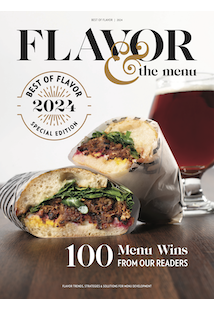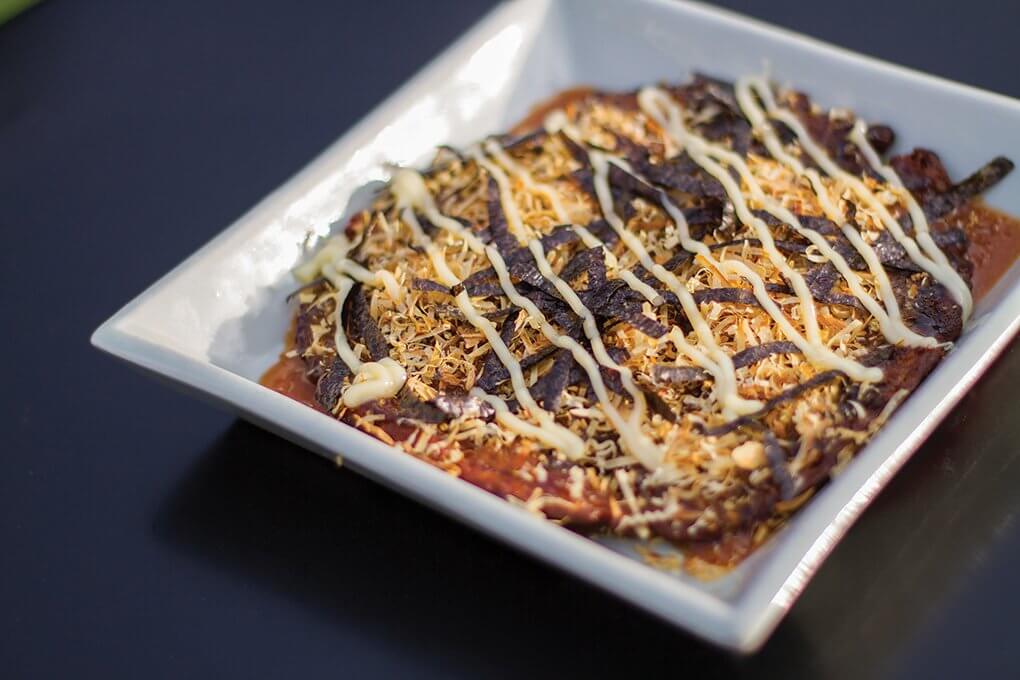It’s always exciting watching a global cuisine take hold, thrilling diners with unfamiliar ingredients, maybe hitched onto familiar flavors and forms to make them less intimidating. For years, Japanese cuisine in this country has stayed within the lines, with restaurants staunchly featuring the standard Japanese-American offerings of sushi, miso soup, edamame, teriyaki chicken and tempura vegetables, with little distinction between concepts. Then came ramen, enticing diners with comforting noodles in savory broth dotted with flavor-forward inclusions, like pork chashu and miso-poached egg. In fact, ramen has opened the doors to further Japanese flavor exploration, inviting chefs and diners to take another look in the Japanese playbook for flavor adventure.
Pushing this exploration even further is the izakaya phenomenon, which sees these casual Japanese brewpubs spinning craveable, often comfort-food-driven small plates. Karaage, Japanese fried chicken, is an izakaya mainstay, as is katsu sando, Japan’s answer to the pork schnitzel sandwich. Those two dishes represent exciting menu opportunity, built around the craveable side of a widely unexplored cuisine with surprisingly approachable adventure. The discovery of izakaya fare has shifted the parameters of Japanese food away from traditional menu stalwarts to exciting, craveable mash-ups. That is what marks this trend and makes it primed for menu opportunity.
The appreciation of umami is another major driver here. Savoriness, craveability and depth of flavor experience—all promised by dishes that boast umami. Consumers now know it, understand it and seek it out. They equate ingredients like soy sauce, fish sauce and other Japanese ingredients with a serious “yum” factor. That’s not a small thing—it explains the enthusiasm in further exploration of Japanese flavors.
“Beyond the few formats and ingredients that Americans are familiar with, few have truly been exposed to other aspects of Japanese food,” says Maeve Webster of Menu Matters consultancy. “So it makes sense that chefs are exploring new elements to bring forward for the American consumer, and it makes even more sense that the majority of what’s being played with are seasonings, sauces, and formats that are either extremely versatile or have basic elements or attributes that are familiar to U.S. consumers.” That is one of the factors driving this trend: the ability of these Japanese flavors and ingredients to hook themselves easily onto American flavor profiles or formats. Like most of today’s menu innovation, successful dishes here aren’t limited to strict replications. Many are eclectic mash-ups that take the best of one cuisine and exploit it in new, delicious ways that are enticing to American diners.
“This trend has a solid foundation of sushi,” says food trends analyst Kara Nielsen. “Fascination with ramen, izakaya, tonkatsu, bento boxes, Japanese seasonings like furikake and togarashi, crispy panko—all are savory and craveable and are helping drive menu interest in Japanese flavors.” Examples abound, demonstrating the reach and the creativity that makes this trend exciting. Look to Mina Test Kitchen in San Francisco for evidence. Its Tokyo Hash Browns embody craveability, with soy caramel, spicy Kewpie mayo, scallions and toasted nori. Short Grain food truck in Charleston, S.C., demonstrates the same street cred with Japanese flavors that Kogi Taco introduced years ago with Korean mash-ups. Short Grain’s rotating menu serves up comfort and craveability with rice bowls like Karaage Don: Japanese fried chicken, cabbage, lemon mayo, slow-cooked egg and sushi rice.

Chef Kirstyn Brewer gives okonomiyaki a seasonal twist with her Kabocha Squash Okonomiyaki at Victor Tangos in Dallas.
Say It with Me: Okonomiyaki
One of the many lessons from the Sriracha craze is that difficulty in pronunciation does not inhibit adoption and enthusiasm, especially if the offering is craveable comfort food. Okonomiyaki is best described as a savory cabbage pancake, often flecked with bacon, spring onion, pork belly or seafood, then topped with a fruit-sweetened soy glaze and Kewpie mayonnaise.
“I cannot overstate my belief that okonomiyaki is ripe for mainstream foodservice,” says Gerry Ludwig, corporate consulting chef for Gordon Food Service. “It is a ‘love at first bite’ dish that hooks the majority of diners with their first taste. The dish holds potential for a variety of foodservice segments. If I owned a sports bar, I would place okonomiyaki on my menu today, and would do the same were I the foodservice director of a college or university.”
Okonomiyaki has taken hold on menus here, mostly in izakaya settings, but innovation is pushing it in interesting ways, showcasing the potential for adoption by differently themed concepts. At Louie’s Gen-Gen Room in San Francisco, a bar bite sees an okonomiyaki waffle with housemade Spam, tonkatsu mayo, corn cabbage and cherry tomatoes. Kirstyn Brewer, executive chef at Victor Tangos in Dallas, switches out the cabbage in her Kabocha Squash Okonomiyaki topped with ham, shrimp and bonito flakes, along with a drizzle of Japanese mayonnaise, tonkatsu sauce and a finish of scallions. Ramen-san in Chicago serves its okonomiyaki three ways on its brunch menu. With a base of batter studded with napa cabbage and pickled ginger, it includes barbecue sauce, mayonnaise and a fried egg. Guests can then customize with crispy pork belly, Berkshire ham and American cheese, 18-hour smoked brisket or braised octopus. Signature takes, coupled with a craveability factor and global intrigue, make okonomiyaki a big menu opportunity.

Crispy bites of karaage, Japanese fried chicken, get hit with a sweet-savory sauce for added craveability.
Japanese Fried Chicken
Fried chicken is one of the most perfect dishes in the American pantheon, with constant adoration and continual interpretation. It’s also claimed by Korea, and that country’s version has made big menu moves over the last few years. In fact, the success of that “KFC” is helping to hold the doors open for karaage, Japan’s fried chicken, which boasts soy-marinated chicken coated in potato starch, then fried until golden and crispy. Izakaya in Houston menus it as a bar bite: Karaage Chicken with spicy yuzu peel marmalade. Susan Weller, VP of global foods with Orrani Consulting, lived in Japan for five years and now teaches Japanese cooking and culture in Denver. “In Japan, thigh meat is typically used for karaage, and it’s served with little bowls of salt and fine white pepper, along with Kewpie mayo,” she says. In Chicago, shishito mustard accompanies the chicken karaage at The Izakaya Lounge at Momotaro while Tengoku Ramen Bar in Arcadia, Calif., serves its version with two dipping sauces: spicy mayo and curry mayo. Masa Kurihara, executive chef, marinates the chicken in ginger, garlic, soy sauce and onion. “The mayo balances out the garlic and ginger, while the curry flavor gives it a unique kick and flavor that you will not find in traditional Japanese chicken karaage,” he says. Daikaya in Washington, D.C., pushes karaage further into American culture by serving a chicken and waffles dish with chicken karaage and red bean taiyaki, along with wasabi butter-maple syrup. Karaage gives chefs here another craveable version of a proven menu favorite.

Mr. Katsu in Fullerton, Calif., serves up craveable Japanese katsu sandwiches. Its fully loaded Yakisoba Katsu offers pork katsu, coleslaw, yakisoba noodles and katsu sauce.
The Next Banh Mi
The Japanese katsu sando holds potential as the next global sandwich phenomenon. Pork breaded with panko, deep fried until insanely crispy, sits between soft, white bread, slathered with tonkatsu sauce, Japan’s sweet-savory barbecue sauce.
As with most sandwiches that promise a craveable combination, innovations have already started to show up on menus here. At Marination in Seattle, the Pork Katsu Sandwich stars pork cutlet with a panko crust on ciabatta with housemade Bulldog sauce, mayonnaise, red onion and tangy slaw. A Pork Katsu Slider comes with cabbage, apple and miso mustard at Top Knot in Dallas. At Mr. Katsu in Fullerton, Calif., diners can choose from a number of katsu-centric choices, including the Katsu Curry Sandwich with a pork cutlet, coleslaw and Japanese curry.
“I recently visited Japan, and they’re everywhere: thick pieces of juicy pork encrusted in a crispy breading—phenomenal,” says Dan Long, chief culinary officer and co-founder of Mad Greens. “If it’s done as well here as in Japan, it’s a home run.” Although pork is generally the hero here, chicken katsu is poised to join the red-hot fried chicken sandwich trend. At Itsy Bitsy Ramen and Whisky in Las Vegas, the Chicken Katsu Sandwich sports shaved cabbage, tomato and spiced tonkatsu sauce.
Even burgers can benefit from the katsu treatment. Katsu Burger, with three locations in Washington, takes the most American dish, the burger, and turns it toward Japanese flavor profiles through add-ons. Its Tokyo Classic Burger features grass-fed beef katsu, Japanese mayo and tonkatsu sauce, and the Teriyaki Chicken Burger stars natural chicken katsu, pineapple, Japanese mayo and teriyaki sauce.

Pork kushiyaki over Japanese coals delivers the flavor of fire, along with complex, savory notes from togarashi and tare sauce (pork, sake, mirin, light soy sauce and black pepper).
Skewered Opportunity
American diners love grilled meats on a stick—from Middle Eastern kabobs to Italian spiedini. Consumers here are somewhat familiar with Japanese yakitori, grilled chicken served on skewers, but now, kushiyaki is making menu moves. Kushiyaki is a broader term, referring to all foods that are skewered and grilled, often in front of the guest. Most commonly cooked over binchotan charcoal, it’s poised for more innovation, especially in the shareable and bar bite space.
“Top Chef” finalist Gregory Gourdet dedicates an entire section of the menu to traditional Japanese skewers at Departure Restaurant + Lounge, with locations in Portland, Ore., and Denver. His Kushiyaki Skewers are grilled over petrified Japanese charcoal. Options range from Yakitori Chicken, Harami Beef Skirt, Kurobuta Pork, Lamb Shoulder, Tiger Prawns and Shiitake Mushroom & Asparagus. “The Japanese charcoal is so different than mesquite,” says Gourdet. “There’s more control with it, and it burns at a much higher temperature, so the food doesn’t have that heavy grilled flavor to it.” Each of the skewers is served with a number of dipping sauces: the yakitori with teriyaki, yuzu, chile and cilantro; the beef with wasabi, crispy elephant garlic and black sesame sauce. “They pack so much flavor, and there’s a refinement to them that is hard not to love,” he says.

Highlighting the craveability and familiarity of college-days ramen-from-a-packet, this version stars a complex broth, grass-fed beef and sugar snap peas.
Sauces & Seasonings
Perhaps the quickest pathway to global flavor discovery is through the infusing of ingredients, which can easily partner with familiar dishes. Japan has a rich culture here, bursting with savory complexity and craveability. “Like Sriracha, the seasonings and sauces from Japanese cuisine likely have the greatest legs because of their versatility in non-authentic applications across nearly the entire menu,” says Maeve Webster. “They can easily blend into a familiar format while lending unexpected flavors, creating a new experience that’s still approachable to the more faint-hearted food experimenter.”
At Tap 415 in San Francisco, the Tap Burger includes tempura bacon, cheddar, lettuce, pickled red onion and togarashi rémoulade. And at Izakaya in Houston, Izakaya Fries feature Japanese curry dip, poached egg and bonito flakes.
Chefs here have begun to discover the glory of furikake and togarashi, two Japanese seasonings that offer complex flavor. “Adding seasonings like furikake or shichimi togarashi to familiar items such as tots or fries or chips only pushes the awareness and eventual desire and demand for those flavor profiles in other dishes,” says Charlie Baggs, founder and executive chef of Charlie Baggs Culinary Innovations. Karasu in Brooklyn, N.Y., menus a potato salad spiked with sweet miso and furikake. In Chicago, togarashi hollandaise modernizes an eggs Benedict on the brunch menu at Mad Social while Michael Armstrong, executive chef of Bodega Negra, turns to togarashi to add depth of flavor and welcome heat to unassuming ingredients. He dusts jicama slices with togarashi and serves them alongside his Bodega Guacamole.
Japanese dishes, flavors and ingredients hold untapped opportunity, promising craveability, complexity and adventure—all qualities that today’s diners seek.










